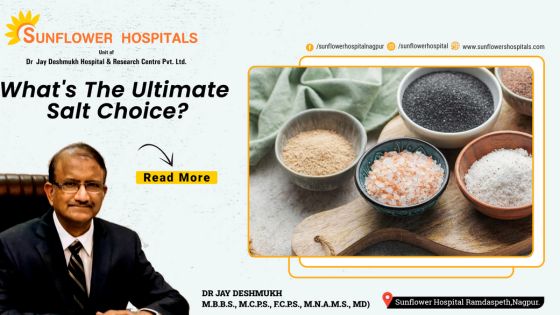What should be the ideal salt intake?
Unfortunately ,most people consume 2-3 times more than the recommended intake. The World Health Organisation and American Heart Association recommend less than 2300 mg salt per day. This is equivalent to one teaspoon full of salt. For maintaining good heart health 1500 mg is recommended per day
What are the health risks of excessive salt?
Excess sodium retains water and increase blood pressure. This is a major risk factor for heart disease, stroke and kidney damage. Reducing salt by 1 gram per day lowers BP by 5 mm. Low-sodium diets reduce stroke risk by 23%. High sodium intake increases stone formation and kidney failure risk. Excessive salt increases calcium loss through urine, weakening bones
Who should reduce salt intake?
Individuals with high blood pressure, kidney disease, heart failure, osteoporosis or stomach ulcers should reduce salt intake. The elderly should also reduce salt intake. Few blood pressure reducing medications reduce excess salt by eliminating it in urine.
What about other salts?
The Himalayan pink salt contains lower salt based on the mineral content. The table salt or refined iodised salt contains 99% of Sodium with small amounts of iodine. Table salt has the highest sodium due to its purity. lodine prevents thyroid gland disease. Celtic sea salt has a low sodium content.
Why is salt necessary?
main component of salt is Sodium. Sodium regulates water distribution and prevents dehydration. Sodium is essential for the nerves and muscles. It regulates blood pressure and helps to maintain acid and alkaline balance.
Which is the best salt?
You have an option of table salt, Kala namak, sea salt, Himalayan pink salt, Celtic sea salt and potassium salt. The best salt for hypertension is the potassium salt and Celtic salt.
What is Sendha namak or rock salt?
It has sodium chloride with various trace minerals. It has large coarse crystals. It is mined from under ground deposits and minimally processed. The sodium content is less than the table salt. The Sodium content is 90 to 95% as against 99% with table salt. Naturally it does not contain iodine. It contains trace minerals like potassium, magnesium and calcium. There are no additives or chemicals. It has milder, subtle taste. It is preferred in fasting, Ayurvedic medicines and natural diets.
In case you have hypertension or diabetes or high cholesterol values it is crucial to lower your sodium intake to prevent heart disease, kidney damage, and stroke. High salt intake leads to osteoporosis.
Author: Dr Jay Deshmukh
Dr Jay Deshmukh is Chief Physician and Director, Sunflower Hospital, Nagpur Honorary Physician to Honorable Governor of Maharashtra and PondicherryCentral. Dr Jay Deshmukh is an M.B.B.S., M.C.P.S., F.C.P.S., M.N.A.M.S., MD From Internal Medicine – Bombay and New Delhi.


